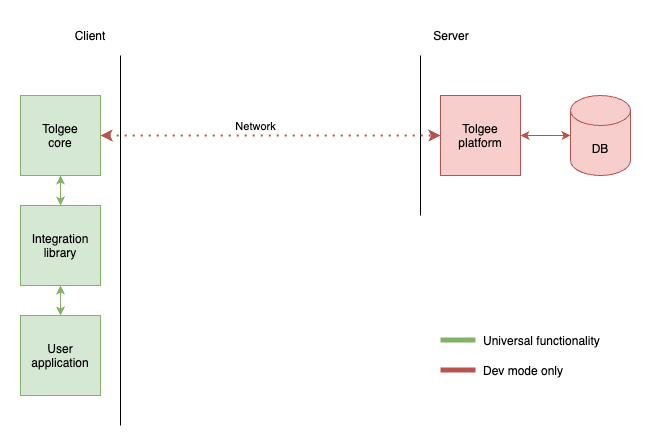In Tolgee.io we needed to implement integrations for all major frontend frameworks. I'd say, that this is quite a good opportunity to show a real world comparison between them and it will allow us to dive into a bit more advanced functionality.
Overall design
Tolgee is a localization platform. Our integration libraries have two purposes:
- Display and format translations in the application + manage language changes
- In dev mode allow "in-context" localization - which means, that user can edit translations directly in the app
So in dev mode our library needs to communicate with our server, but in production mode it will only deal with generated JSON files, containing translations.

General integration library architecture
Integration libraries provide tailored API for given framework and only need to React on translation/language changes, coming from core library.
Translating regular texts
Every integration needs to provide a way to translate regular texts on the page in form of special component, so user
can simply use the component and we need to make sure, that correct translation is displayed (based on selected
language). We are using ICU message format, which allows passing
variables, so user can also pass named parameters, which are referenced in translation self and translation strings can
look like You have {itemsCount} items in your cart. In ideal scenario we'd like something like this:
<T keyName="cart_content_key" parameters={{ itemsCount: 5 }} />
My main working tool is React and so I use React as kind of reference implementation
Translating imperatively
Translations can occur not only directly as children in DOM elements, but also in parameters like title
or aria-label. For these cases we can't use component, but we need some user callable function, which will translate
the text for him imperatively. E.g.:
<div title={t('translation_key')}>...</div>
Source of data
We need a way to provide tolgee/core instance and ideally we don't want limit it for just one (user might want to use
multiple different sources of translations in the same project). Ideal would be to provide the instance globally or to a
subtree of components in the application (In React it's exactly what Context API does).
Implementation for React
In React we use context API to provide Tolgee instance to all children:
export const TolgeeProviderContext = React.createContext(null);
export const TolgeeProvider = ({ config, children }) => {
const [tolgee] = useState(new Tolgee(config));
useEffect(() => {
tolgee.run();
return () => {
tolgee.stop();
};
}, []);
return (
<TolgeeProviderContext.Provider value={{ tolgee }}>
{children}
</TolgeeProviderContext.Provider>
);
};
Now let's look how we can use Tolgee context in T component:
export const T = ({ keyName, parameters }) => {
const { tolgee } = useContext(TolgeeProviderContext);
// get initial value
const [translated, setTranslated] = useState(
tolgee.instant(keyName, parameters)
);
useEffect(() => {
// subscribe to translation changes
const subscription = tolgee.onTranslationChange.subscribe((data) => {
if (data.key === keyName) {
setTranslate(tolgee.instant(keyName, parameters));
}
});
return () => {
subscription.unsubscribe();
};
}, [keyName, parameters]);
return translated;
};
Tolgee instance holds internal cache with all current translations. So when we call tolgee.instant(), we'll get
current translation of the key with applied parameters, also we can subscribe to translation changes, which happen e.g.
when language is changed or when user manually changes the translation through in-context localization tool.
Imperative translating in React
To create simple to use t function in React, we need to somehow "hook" it to component lifecycle as we need not just
to translate keys, but also subscribe the component to translation changes. Simplest solution (as I might given you a
hint) is to create hook, which returns this t function. Then we have separate t function for each component and we
can connect it to the component lifecycle. Let's look how that can look like.
export const useTranslate: () => ReturnFnType = () => {
const { tolgee } = useTolgeeContext();
// dummy state to force component to re-render
const [_, setDummyValue] = useState(0);
const reRender = () => {
setDummyValue((v) => v + 1);
};
// array of used keys
const usedKeysRef = useRef(new Set());
useEffect(() => {
const subscription = tolgee.onTranslationChange.subscribe((data) => {
// check if we are using this key
if (usedKeysRef.current.has(data.key)) {
reRender();
}
});
return () => subscription.unsubscribe();
}, []);
return (keyName, parameters) => {
// remember that this key was used
usedKeysRef.current.add(keyName);
return tolgee.instant(keyName, parameters);
};
};
React doesn't have a direct way how to force component to re-render, so we do it through dummy state update.
This hook can be then used in following way:
export const MyComponent = () => {
const t = useTranslate();
return <div title={t('title_key')}>...</div>;
};
We basically give user a function and then observe what keys is he using it for. When translation changes, we check if it was used before in this component and eventually we force component to re-render.
Notes
Implementation for all frameworks and is quite simplified in order to fit into one article. The core library is in reality a bit more complex, also we've completely skipped in-context localization event handlers (that allows user to click on translation), as it is quite complicated subject.
Implementation for Vue.js
Vue.js has also concept of providing a context to it's children. We can do this by provide method on any component.
export const TolgeeProvider = {
name: 'TolgeeProvider',
props: {
config: { type: Object, required: true },
},
created() {
const tolgee = new Tolgee({ ...this.$props.config });
this.tolgeeContext.tolgee = tolgee;
tolgee.run();
},
data() {
return {
tolgeeContext: {
tolgee: null,
// more reactive properties here
},
};
},
provide() {
return {
tolgeeContext: this.tolgeeContext,
};
},
beforeUnmount() {
this.tolgeeContext.tolgee.stop();
},
render() {
this.$slots.default();
},
};
Vue is using methods to manage lifecycle of the component, it is quite similar to React class components. Where Vue
is quite different is that it's using reactive objects - everyting you put inside data property, will get turned into
reactive objects (which are watching for changes), so that way Vue triggers re-renedering. In example above, we are
putting a whole tolgeeContext into data property because in reality we need more things to be passed down and it
needs to be reactive.
Now let's look how T component can work.
export const T = {
name: 'T',
inject: ['tolgeeContext'],
props: {
keyName: { type: String, required: true },
parameters: Object,
},
data() {
const tolgeeContext = this.tolgeeContext;
return {
translation: tolgeeContext.tolgee.instant(
this.$props.keyName,
this.$props.parameters
),
};
},
methods: {
translate(data) {
if (data.key === this.$props.keyName) {
this.$data.translation = tolgeeContext.tolgee.instant(
this.$props.keyName,
this.$props.parameters
);
}
},
},
created() {
const tolgeeContext = this.tolgeeContext;
this.$options.subscription =
tolgeeContext.tolgee.onTranslationChange.subscribe(this.translate);
},
beforeUnmount() {
this.$options.subscription.unsubscribe();
},
render() {
return this.$data.translation;
},
};
Similarly as in React, we use tolgeeContext through inject property and subscribe to
translation changes in lifecycle methods.
Imperative translating in Vue
As we don't have anything like hooks in Vue, we'll have to use it's Mixin api. Mixin is a way how to share logic
between components while using it's lifecycle methods.
export const TolgeeMixin = {
inject: ['tolgeeContext'],
beforeCreate() {
this.$options.usedKeys = new Set();
},
created() {
const tolgeeContext = this.tolgeeContext;
this.$options.subscription =
tolgeeContext.tolgee.onTranslationChange.subscribe((data) => {
if (this.$options.usedKeys.has(data.key)) {
this.$forceUpdate();
}
});
},
methods: {
$t(keyName, params) {
this.$options.usedKeys.add(keyName);
const tolgeeContext = this.tolgeeContext;
return tolgeeContext.tolgee.instant(keyName, params);
},
},
beforeUnmount() {
this.$options.subscription.unsubscribe();
},
};
Mixin can then be used following way:
<template>
<div :title="$t('title_key')">...</div>
</template>
<script>
export const Component = {
mixins: [TolgeeMixin],
};
</script>
So here we inject tolgeeContext, subscribe into translation changes and add $t method, which can then be used by the
user. We also maintain a list of keys, which were used and we update the component when they change. Notice that
Vue has explicit method $forceUpdate, which causes re-render of the component.
Implementation in
Svelte and Angular sections are written by Jan Cizmar, as he is the author of the integrations
In Svelte we implemented the provider quite similarly as in Vue and React.
<!-- TolgeeProvider.svelte -->
<script>
import { onDestroy, onMount, setContext } from "svelte";
export let config: TolgeeConfig;
const tolgee = new Tolgee(config);
setContext("tolgeeContext", { tolgee });
onMount(() => tolgee.run());
onDestroy(() => tolgee.stop());
</script>
<slot />
The T component that uses the context looks like this:
<script>
import { onDestroy, getContext } from "svelte";
export let keyName;
export let parameters;
const tolgeeContext = getContext('tolgeeContext');
let translated
const translate = () => {
translated = tolgeeContext.tolgee.instant(
keyName,
parameters,
);
}
translate();
const subscription =
tolgeeContext.tolgee.onTranslationChange.subscribe((data) => {
if (data.key === keyName) {
translate()
}
});
onDestroy(() => {
subscription.unsubscribe();
});
</script>
{translated}
The TolgeeProvider and T component are very similar to React implementation.
The differences are:
- Svelte has lifecycle methods, React has hooks
- Context API has is a bit different
Imperative translating in Svelte
The biggest difference from React integration is in the getTranslate method, which in Svelte returns a Store
containing the method to actually translate the key.
import { onDestroy, getContext } from 'svelte';
import { derived, writable } from 'svelte/store';
export const getTranslate = () => {
const context = getContext('tolgeeContext');
const tolgee = context.tolgee;
// set of used keys
const usedKeys = new Set();
// dummy store which is updated to forces providing of new translate method
const updateStore = writable(0);
const update = () => updateStore.update((number) => number + 1);
const translate = (keyName, params) => {
usedKeys.add(keyName);
return tolgee.instant(keyName, params);
};
const subscription = tolgee.onTranslationChange.subscribe((data) => {
if (usedKeys.has(data.key)) {
update();
}
});
onDestroy(() => {
subscription.unsubscribe();
});
// return new translate method when something is changed
return derived(
// when updateStore changes, translate function gets changed as well
updateStore,
() => (keyName, params) => {
return translate(keyName, params);
}
);
};
Example usage of getTranslate function:
<script>
const t = getTranslate();
</script>
<div title={$t('title_key')}>...</div>
In React the useTranslate is hook, which is basically modifying state to force rerender when translation changes and
the returned t function called by the new render then returns new value.
Similar thing happens in Svelte, but there the t is actually a Store containing the translating function. That's why
there is the $ before the function call. It means that the value should be re-rendered whenever the Store is updated.
Angular
The most different approach is used in Angular integration. Angular has no concept of provider, instead we can use module, which setups the Tolgee Core library and provides the service, pipe and component to allow translating in the module components.
The NgxTolgeeModule
@NgModule({
declarations: [TranslatePipe, STranslatePipe, TComponent],
exports: [TranslatePipe, STranslatePipe, TComponent],
providers: [],
})
export class NgxTolgeeModule {
// @dynamic
static forRoot(options: TolgeeConfig): ModuleWithProviders<NgxTolgeeModule> {
options = { filesUrlPrefix: '/assets/i18n/', ...options };
return {
ngModule: NgxTolgeeModule,
providers: [
TranslateService,
TranslationsProvider,
{
provide: APP_INITIALIZER,
useFactory: (provider: TranslationsProvider) => {
return async () => await provider.load(options);
},
deps: [TranslationsProvider, TranslateService],
multi: true,
},
{ provide: TolgeeConfig, useValue: options },
],
};
}
}
Cool thing about this is the factory, which enables us to wait for translations to be loaded before it renders the application to the DOM. In other frameworks, this is handled by loadingFallback props or slots, which are rendered when translations are loading.
The translation service and Observables
In Angular world RxJs and its Observable interface are very popular. The Observable is similar thing as an event emitter. It enables us to emmit new values until we are done and enables us to unsubscribe when we need so. This is exactly what we need for our purpose.
import { EventEmitter, Injectable, OnDestroy } from '@angular/core';
import { Observable } from 'rxjs';
import { Tolgee, TranslationData } from '@tolgee/core';
import { TolgeeConfig } from './tolgeeConfig';
@Injectable()
export class TranslateService implements OnDestroy {
constructor(private config: TolgeeConfig) {}
// Logic creating the Instance of Tolgee and lot of other stuff is ommited
// ...
private _tolgee: Tolgee;
public get tolgee(): Tolgee {
return this._tolgee;
}
public translate(key: string, params = {}): Observable<string> {
return new Observable((subscriber) => {
const translate = () => {
const translated = this.tolgee.instant(key, params);
subscriber.next(translated);
};
translate();
const onTranslationChangeSubscription =
this.tolgee.onTranslationChange.subscribe((data) => {
if (data.key === key) {
translate();
}
});
return () => {
onTranslationChangeSubscription.unsubscribe();
};
});
}
}
The service's translate method creates new Observable and emits new value every time translation is changed, which is
emitted by Tolgee instance from @tolgee/core library. It also returns function, which enables us to unsubscribe.
The component with t attribute selector
As an equivalent to T component in React, we can use t selector, it subscribes to translate Observable and changes the result according to the new value.
import { Component, ElementRef, Input, OnDestroy, OnInit } from '@angular/core';
import { Subscription } from 'rxjs';
import { TranslateService } from './translate.service';
import { TOLGEE_WRAPPED_ONLY_DATA_ATTRIBUTE } from '@tolgee/core';
@Component({
selector: '[t]',
template: ``,
})
export class TComponent implements OnInit, OnDestroy {
@Input() params?: Record<string, any>;
@Input() key: string;
subscription: Subscription;
constructor(
private ref: ElementRef,
private translateService: TranslateService
) {}
ngOnInit(): void {
const element = this.ref.nativeElement as HTMLElement;
element.setAttribute(TOLGEE_WRAPPED_ONLY_DATA_ATTRIBUTE, this.key);
this.subscription = this.translateService
.translate(this.key, this.params, this.default)
.subscribe((translated) => {
return (element.textContent = translated);
});
}
ngOnDestroy(): void {
this.subscription.unsubscribe();
}
}
The translate pipe
Pipe is a feature, which is missing in all the other integrations. It's basically function, which is able to change value used in template to some other value.
import { OnDestroy, Pipe, PipeTransform } from '@angular/core';
import { TranslateService } from './translate.service';
import { Subscription } from 'rxjs';
@Pipe({
name: 'translate',
pure: false,
})
export class TranslatePipe implements PipeTransform, OnDestroy {
value = '';
key: string;
params: Record<string, any>;
private subscription: Subscription;
constructor(protected translateService: TranslateService) {}
ngOnDestroy(): void {
this.unsubscribe();
}
transform(key: any, params?: Record<string, any>): string {
if (
this.key === key &&
JSON.stringify(this.params) === JSON.stringify(params)
) {
// parameters unchanged
return this.value;
}
this.key = key;
this.params = params;
this.unsubscribe();
this.subscription = this.translate(key, params);
return this.value;
}
private unsubscribe() {
this.subscription.unsubscribe();
}
private translate(key, params) {
this.translateService.translate(key, params).subscribe((r) => {
this.value = r;
});
}
}
Angular is basically running the transform method every time the user moves mouse or hits some keys, since it is impure pipe, which may return different result for the same input. That happens when language is changed: same key and params, different result.
In comparison to other frameworks it seems that Angular library needs a bit more code and the integration is more complicated.
Conclusion
It is interesting, how these frameworks/libraries take inspiration from each other. Svelte being the newest has something from everyone and the code seems very natural and clean. Vue takes inspiration from both Angular and React and is kinda compromise between them. Then you have React, which stands out with hooks and JSX. And Angular taking inspiration from "classic" Model-View-Controller schema, which is familiar to backend developers.
We'll be glad if you let us know how to improve/simplify an implementation in any of these frameworks/libraries. We don't claim that we know all these frameworks that well. I've used Vue seriously for the first time and Jan was learning Svelte from scratch, while he was implementing this (their documentation is outstanding).


